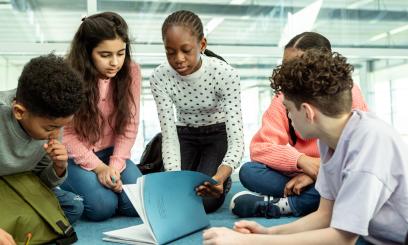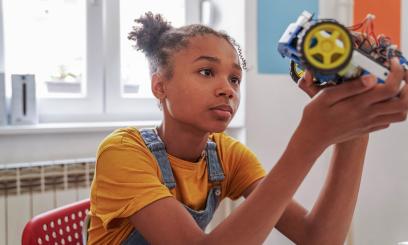In project-based learning (PBL) activities, students investigate, ask questions about, and design hands-on solutions to real-world problems and challenges. These opportunities to “learn by doing” and connect classroom concepts to their experiences help students acquire deep knowledge and skills that enhance their academic achievement. That’s why experiential learning is one of the key transformative learning strategies addressed through the AFT’s Real Solutions for Kids and Communities campaign to help children recover and thrive. (Learn more at aft.org/realsolutions.)
Share My Lesson has dozens of resources—including lesson plans and activities, blog posts, webinars, and more—to help educators develop meaningful PBL activities for the classroom. Here, Amber Chandler, a regular Share My Lesson contributor and presenter, describes how PBL can accommodate students’ differing needs. (To read this blog post on SML, visit sharemylesson.com/blog/pbl-journey.)
To learn more about PBL lesson plans and projects that you can adapt for your classroom, visit the Share My Lesson collection “Growth Mindset and Project-Based Learning Lesson Plans” at go.aft.org/vvs.
–EDITORS
I’m just going to rip off the Band-Aid and say this part up front: as a result of the pandemic, many students are not equipped to do project-based learning (PBL) like they may have been in 2019. This is not because of some “learning loss” or failure of their families or teachers to keep them moving in the right direction. Instead, students will struggle with PBL because they don’t have the social skills scaffolding in place right now. What do I mean by this, exactly? Take, for example, the collaborative project from 2019 that my students did after reading The Giver.* This project required students to plan out a utopia—working in groups, on a single document, from multiple computers—after brainstorming with each other and me. If I had tried to do this project when we returned to school, in masks, six feet apart, it would never have worked, for obvious reasons. So, like so many others, I sacrificed PBL to work with students on regaining some of the other stunted “school skills,” particularly helping them with social and emotional skills and helping them to regain stamina for academic work and interpersonal interactions.† My lesson “Using Biography to Build Community” (available at go.aft.org/w2i) is one example of how I tried to help students reacclimate to school and to build stamina.
This year, however, I’m ready to head back to PBL, and so were a dozen other teachers who were members of my recent class, “Project-Based Learning Post-Pandemic.” My slide overview (available at go.aft.org/hm8) provides an explanation of the philosophy I’ll be taking with my students. I’ll share how PBL helps four “types” of students: Suzy, Bryan, Jane, and Ollie. They are an amalgamation of students I’ve had over the years, and the goal is to make sure I offer them project-based learning opportunities that allow them all to have the same “view from the top.” They will each need different scaffolding, perhaps a variety of modalities, lots of encouragement and understanding, but always a strong belief that though their paths may be different, they will experience a rigorous and worthwhile educational journey. Here’s what that will look like:
Suzy
Suzy is creative and funny, but she has some learning difficulties that, if left unsupported, might prevent her from reaching the learning target. She may have a 504 plan, an individualized education plan, or some mental health issues, or she may be learning a new language. Though there are nuances that are impossible to capture in an individual example, it is safe to say that students who have any or all of these characteristics often need to have simplified directions with fewer steps. Also, there are times when the anticipatory set is unnecessary and can sidetrack students who might have difficulty cognitively grasping the scope and the sequence of a project. Suzy will benefit from choice, support, and encouragement. Rigor isn’t sacrificed, but rigidity isn’t necessary either.
Bryan
Bryan is the type of student who wants to do it his way, and we can encourage that attitude while also checking in with him along the way to make sure he is meeting the requirements. It is important to support students like Bryan, who are capable but perhaps a tad rebellious or bored with their current learning opportunities, to expand their skills and experiences. Bryan may have had things come easily to him before, but his grade might have suffered because he rushed through them. By using a checklist and detailed rubric, teachers can help students like Bryan be successful. Another key component with all students, but in my opinion particularly those not meeting their potential, is to elicit help from family and even coaches. Students like Bryan often need a team around them to make sure they don’t check out. Bryan is often a student who knows the material but just doesn’t know how to let their guard down enough to experience academic success, often because it doesn’t go with the rest of their persona. Make sure the Bryans have choices that make sense to them, but don’t sacrifice rigor.
Jane
Jane is the stereotypical overachiever. Instead of simply letting her do the basics and coasting through, the teacher can offer her extension activities and/or the potential to circle back and help others. As a former “Jane,” I was often forced to help those who were struggling, and it negatively impacted my opinion of group work. Instead of assigning a student like Jane another student to help, it is better to allow her to decide if she wants to offer her skills to anyone who might need them. For example, if Jane is a great artist, she can be allowed to set up a section of the classroom to help any student who needs guidance in that area. This isn’t simply for the Janes of the world, either—Bryan might have some skills he can offer the class as well, and students learn to check with their learning community for help. I have all students create a “business card” of their skills and tack it to our bulletin board if they are willing to work with other students. We discuss talents that are useful to school, and I’m always so proud of the students who are willing to share themselves for the betterment of the whole class. It is especially heartwarming to have the Suzys of the world recognize that though some parts of academia are hard, they still have things to offer overall. This way, when students need help, I’m able to direct them to check the bulletin board first in order to help create interdependence.
Ollie
Ollie is the kiddo who doesn’t like school. These students can be smart, talented, and polite, and have all the other “school” qualities we love, but they find the whole thing a bit pointless. They can often solve a Rubik’s Cube, play an instrument, or be a really successful athlete. Some are shy and loners. School, though, is not interesting to them (maybe due to anxiety or depression, or maybe just as a part of their experience). Just because you say that the journey is worthwhile to meet a learning target doesn’t mean they will believe you. The structure of school is the issue. Ollies may need more choices than other students, and they will thrive if their creativity is validated and valued instead of squashed. School is meant to create copies, and Ollies are more interested in being original—not as a counter activity, but because they are only comfortable when allowed to pursue their interests as they relate to the larger context.
***
Of course, there are multitudes of other “types” of students, and these are only to serve as examples. No one wants to be reduced to a paragraph descriptor, but the takeaway is simple: all learning doesn’t have to look the same with the same steps, pathway, or even number of assignments. What is important is for educators to offer all students rigorous, worthwhile paths that all lead to a “view at the top” of a learning goal. That learning goal, whatever it may be, must be scaffolded in a way that it is accessible to all types of learners; and educators need to value the learning journey and honor it for all students by recognizing that they learn things along the way that were not planned explicitly by the teacher. That learning is crucial too!
My “Project-Based Learning Post-Pandemic” slideshow visualizes what these students’ project-based learning experiences might look like. The beauty of PBL is that all of these learning styles and needs can be accommodated through a well-designed project. Follow the “BAM” method: help students create Burning questions, incorporate Authentic audiences into the experience, and make sure that Millennial skills are front and center to the project. Check out the plethora of materials found at pblworks.org, and use the slideshow from my class to create something you and your students will learn from. Reach out to me at amberrainchandler@gmail.com with any questions you might have, and please share the learning!
Amber Chandler is the president of the Frontier Central Teachers Association in New York and a national board certified middle school English language arts teacher in Hamburg, New York. She has a master’s degree in literature as well as a school building leader certification.
*To view the collaborative project, visit go.aft.org/uzw. (return to article)
†To learn how book clubs can help develop students’ interpersonal and academic skills, visit go.aft.org/w19. (return to article)
[Photos by iStock]


